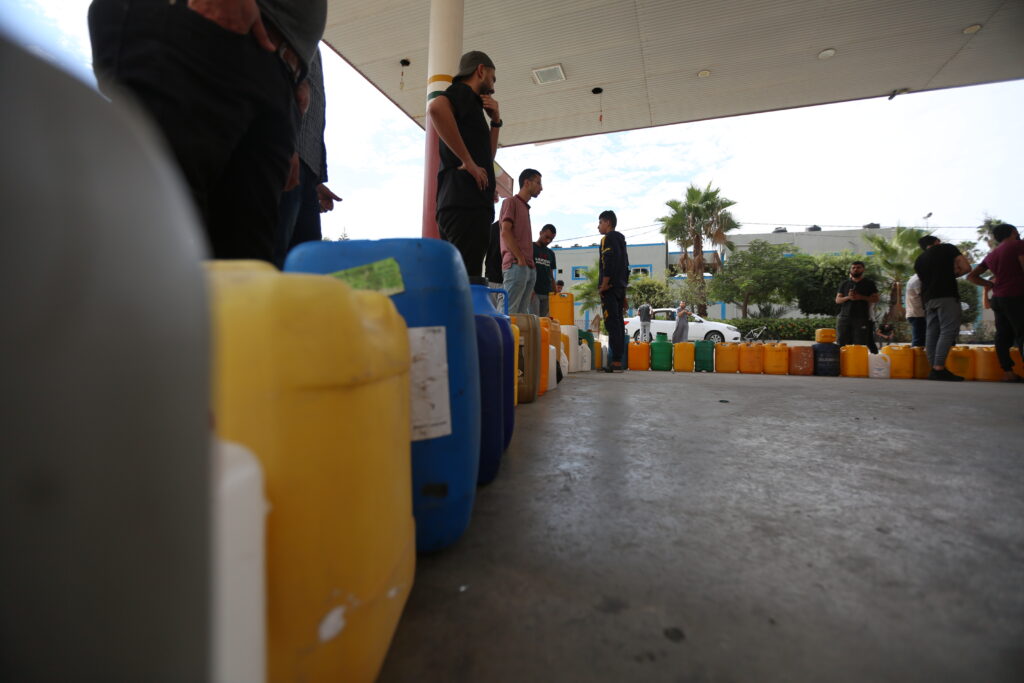After 5 long months of war, the entire Gaza Strip is on its knees. Death, devastation, hunger, misery – this is what Gaza is experiencing, where millions of people are on the brink of despair.
The war statistics are terrifying: as at 10:30 on 8 March 2024, at least 30,878 Palestinians were killed in Gaza and 72,402 Palestinians were injured. The displacement crisis is acute, with more than 1.7 million people – over three-quarters of Gaza’s population – forced to flee their homes. Almost 1.4 million of them have sought refuge in the Rafah area, relying on makeshift shelters for survival.
CESVI – which has been working in the occupied Palestinian territories since 1994 – has managed to enter the Gaza Strip from the Rafah crossing with a shipment of 18 tonnes of Ready-to-use Therapeutic Food (RUTF). This lifesaving shipment is aimed at mitigating severe acute malnutrition among thousands of children under five. The cargo has reached a warehouse in Rafah and our staff on the ground is coordinating with humanitarian partners to distribute it to the most vulnerable children in the Strip.

credits: CESVI 
Severe damage to agrifood systems
The humanitarian situation in Gaza has become increasingly dire, with agrifood systems facing unprecedented challenges. Severe restrictions on fuel shipments have led to crippling effects on water infrastructure, desalination plants, and the production and delivery of key food commodities, significantly disrupting agricultural activities, food processing, and distribution. Electricity shortages have further exacerbated these issues, with the Gaza Strip relying on minimal electricity from solar panels and generators due to fuel scarcities. The drastic reduction in the water supply to a mere 7% of its pre-conflict levels has led to acute shortages of safe water necessary for food processing. Consequently, the commercial sector, particularly essential for food imports, has been nearly obliterated, leading to rapid depletion of food stocks.
The conflict has also severely impacted Gaza’s self-sufficiency in fruits and vegetables, decimated agricultural infrastructure, and led to a significant decline in crop health and density. Moreover, the livestock sector has suffered greatly, with a substantial loss of animals due to lack of water and fodder. The sea fishing sector, vital for nutrition and income for over 100,000 people, has been brought to a standstill.
These developments have not only damaged Gaza’s agrifood systems but have also posed severe threats to food security and livelihoods, highlighting the urgent need for international humanitarian intervention.

Credits: CESVI 
People on the brink of famine
According to the latest available Integrated Food Security Phase Classification (IPC) analysis, the entire population of the Gaza Strip – about 2.2 million people – is estimated to be in Crisis or worse levels (IPC Phase 3 and above). This is the highest percentage of people experiencing acute food insecurity ever recorded by the IPC for any given area or country. Half of the population is estimated to be in Emergency (IPC Phase 4) and at least 1 in 4 households – about 500,000 people – are projected to be in Catastrophic or famine-like conditions (IPC Phase5).
This implies that all children under five in the Gaza Strip – more than 335,000 – are at high risk of severe malnutrition and preventable death as the risk of famine conditions continues to increase. In addition, more than 80% of young children are experiencing severe food poverty and there is increasing concern about the nutrition of over 155,000 pregnant women and breastfeeding mothers, as well as for over 135,000 children under two, given their specific nutrition needs, which are compounded by stress and trauma.
According to the latest media report, at least 20 people – mainly children – have already died from malnutrition and dehydration in northern Gaza and there is increasing concern also for children and vulnerable population groups also in Rafah, despite having more access to humanitarian aid.

Voices from the ground
The stories of people on the ground – collected by our staff – echo the desperation and resilience of Gaza’s inhabitants. Rapidly rising food prices and the scarcity of basic necessities have made survival a daily struggle.

“The problems we face are numerous: in addition to the constant threat of violence, we also have to deal with inflation. The cost of food is skyrocketing: sugar is at 80 shekels. To make a simple cup of tea in the morning, I must consider the cost of cooking gas, tea itself, sugar, and water,” says a man in Gaza. “Where do we find these ingredients? How can we afford fresh vegetables when they are so expensive? We’re tired of eating canned food, but we can’t afford anything else. We struggle every day to put food on the table, to ensure our children even have their daily bread. We can’t even afford a biscuit for our children. We are desperate, but we must fight, for ourselves and for future generations,” he concludes.
“My main concern is my children. I need daily diapers for them, milk for the youngest. The cost of a carton of milk is 27 shekels, an expense that weighs heavily on our already precarious finances. Even diapers are a luxury we can’t afford,” says a woman. “The cost of living has become very high. Before the war, we could afford six kilograms of tomatoes for a few shekels, today not even two tomatoes for breakfast are within our reach. Even bread, a basic necessity, has become a luxury. Bakeries sell one piece for 5 shekels. We need support to guarantee a better future for our children and to live with dignity,” she concludes.


